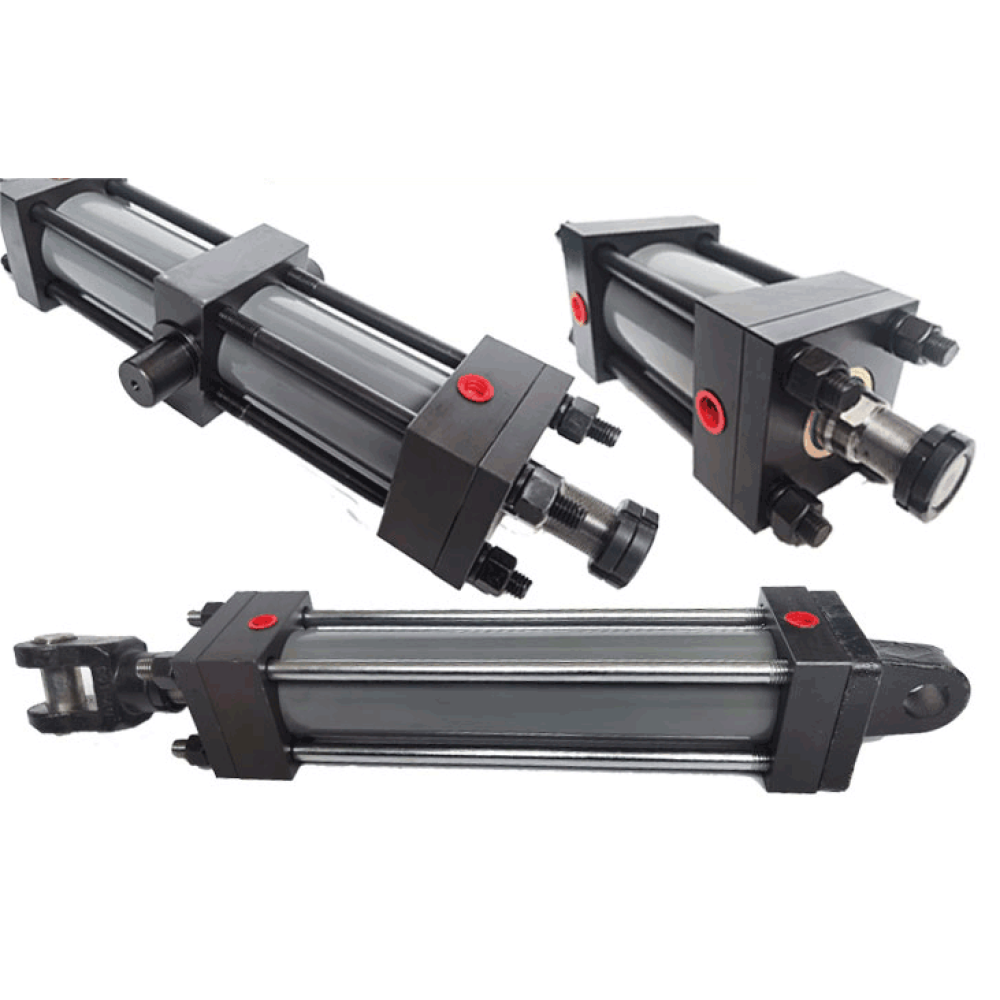A hydraulic cylinder is a hydraulic actuator that converts hydraulic energy into mechanical energy and can perform linear reciprocating motion (or swinging motion). It has a simple structure and reliable operation. When achieving reciprocating motion, the use of a hydraulic cylinder can save the reduction device, and there is no transmission gap, and the movement is smooth. Therefore, it has been widely used in the hydraulic systems of various machines.



Composition:
The output force of the hydraulic cylinder is proportional to the effective area of the piston and the pressure difference on both sides. The hydraulic cylinder is mainly composed of a cylinder barrel and a cylinder head, a piston and a piston rod, a sealing device, a buffer device and an exhaust device. The specific configuration of the buffer device and the exhaust device depends on the application, while other devices are indispensable.
Hydraulic transmission principle: using oil as the working medium, transmitting motion through the change of sealed volume, and transmitting power through the pressure inside the oil.
Power part: converting the mechanical energy of the prime mover into the pressure energy (hydraulic energy) of the oil. For example: hydraulic pump.
Execution part: converting the oil pressure energy input by the hydraulic pump into the mechanical energy to drive the working mechanism. For example: hydraulic cylinder, hydraulic motor.
Control part: used to control and adjust the pressure, flow and flow direction of the oil. For example: pressure control valve, flow control valve and direction control valve.
Auxiliary part: connecting the previous three parts together to form a system, which plays the role of oil storage, filtering, measurement and sealing. For example: pipelines and joints, oil tanks, filters, accumulators, seals and control instruments, etc.
Parameter:
The main parameters of hydraulic cylinders include pressure, flow, size, piston stroke, movement speed, push-pull force, efficiency and hydraulic cylinder power.
Pressure: Pressure is the pressure of oil acting on a unit area. The calculation formula p=F/A, that is, the load acting on the piston divided by the effective working area of the piston. On the same effective working area of the piston, the greater the load, the greater the pressure required to overcome the load.
Hydraulic cylinders can be divided into the following specifications according to the operating pressure: 70kgf/cm2 (7Mpa) is called a low-pressure hydraulic cylinder, 140kgf/cm2 (14Mpa) is called a medium-pressure hydraulic cylinder, and 210kgf/cm2 (21Mpa) is called a high-pressure hydraulic cylinder.
Flow rate: Flow rate is the volume of oil passing through the effective cross-sectional area of the cylinder per unit time. The calculation formula is Q=V/t=vA, where V represents the volume of oil consumed in one stroke of the hydraulic cylinder piston, t represents the time required for one stroke of the hydraulic cylinder piston, v represents the movement speed of the piston rod, and A represents the effective working area of the piston.
Piston stroke: The piston stroke refers to the distance traveled between the two poles when the piston reciprocates. Generally, after the stability requirements of the cylinder are met, a standard stroke similar to it is selected according to the actual working stroke.
Piston movement speed: The movement speed is the distance that the pressurized oil pushes the piston to move per unit time, which can be expressed as v=Q/A.
Dimensions: Dimensions mainly include the inner and outer diameters of the cylinder, the piston diameter, the piston rod diameter and the cylinder head size. These dimensions are calculated, designed and verified based on the use environment of the hydraulic cylinder, the installation form, the required push-pull force and the stroke.

Interior Design:
1. The selection of seals must be based on the on-site working temperature, environmental pollution, and working medium. Polyurethane seals cannot be used for water-ethylene glycol media.
2. The cylinder head of the oil cylinder should use V-type combined seals as much as possible, which can make up for the error in the groove processing finish.
3. The size of the sealing groove is strictly designed according to the design manual.
4. The oil cylinder piston seal generally uses a Gly ring plus a guide belt. The Gly ring has good high temperature resistance and pollution resistance.
5. The cylinder seal generally uses the Japanese NOK series. Do not use domestic oil cylinder seals, otherwise the cylinder starting resistance is too large, the movement is not stable or even does not work.
6. The O-ring seal between the cylinder head, cylinder bottom and cylinder barrel is best to add a retaining ring, which can make up for the processing error.
7. The connection between the cylinder barrel and the cylinder head, cylinder bottom and the middle swing should not be welded as much as possible, because welding will cause the cylinder barrel to deform. Threaded connection or other connection methods can be used.

FAQ and Repair:
Hydraulic cylinder oil leakage: External leakage of oil from various loose seals to the atmosphere outside the hydraulic cylinder. The most common external leakage is the following three places:
(1) Oil leakage at the sealing part of the hydraulic cylinder sleeve and the cylinder head (or guide sleeve) (solution: replace the new O-ring);
(2) Oil leakage at the relative movement of the piston rod and the guide sleeve surface (solution: if the piston rod is damaged, it can be cleaned with gasoline, and after drying, metal glue is applied to the damaged part, and then the piston rod oil seal is moved back and forth on the piston rod to scrape off the excess glue, and then put into use after the glue is completely cured. If the guide sleeve is worn, a guide sleeve with a slightly smaller inner diameter can be processed for replacement);
(3) Oil leakage caused by loose sealing of the hydraulic cylinder pipe joint (solution: in addition to checking the sealing condition of the sealing ring, you should also check whether the joint is correctly assembled, whether it is reliably tightened, and whether there are any scratches on the contact surface, etc., and replace or repair it if necessary)
Hydraulic cylinder oil leakage: Internal leakage is the leakage of oil from the high-pressure chamber to the low-pressure chamber through various gaps inside the hydraulic cylinder. Internal leakage is difficult to detect and can only be judged by the system working conditions, such as insufficient thrust, speed reduction, unstable operation or increased oil temperature. Internal leakage of hydraulic cylinders generally occurs in the following two places: (1) The static seal between the piston rod and the piston (solution: install O-rings on the sealing surfaces of both);
(2) The dynamic seal between the inner wall of the cylinder sleeve and the piston (solution: when internal leakage is found, all mating parts should be strictly inspected first. The repair of the cylinder sleeve usually adopts the method of boring the inner hole, and then matching the piston with a larger diameter)

